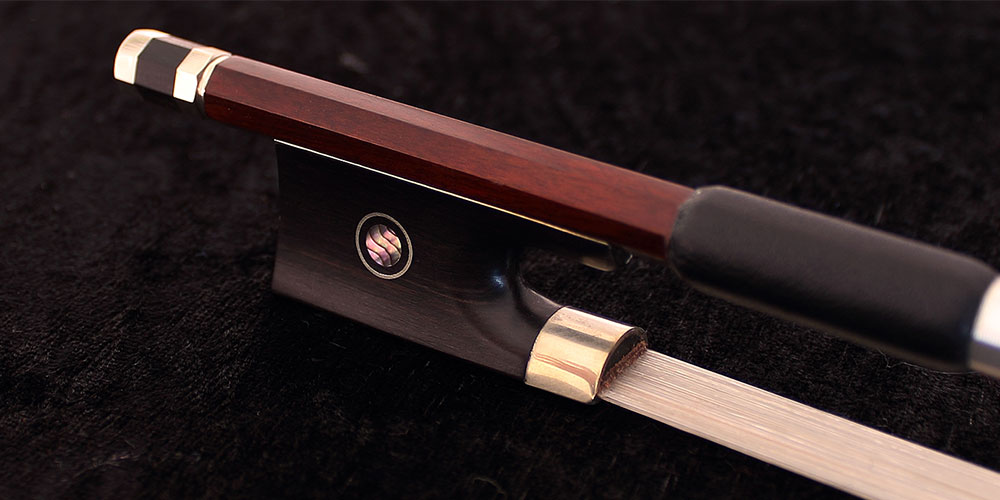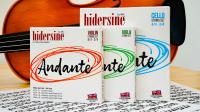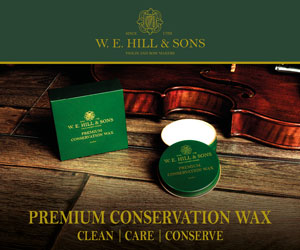Top Tips for Taking Care of Your Bow

Content courtesy of Hidersine Orchestral
CLEANING YOUR BOW'S STICK, FROG & OTHER ESSENTIAL PARTS:
Remember, you hold your bow for prolonged periods which can make your bow’s frog dirty and tarnished pretty quickly if not properly cleaned after use. It’s not too nice to talk about, but our skin gets oily and sweaty, and these secretions are easily transferred to your bow - especially as your bowing hand moves so much.
If not regularly cleaned, these skin deposits will soon start to take their toll on the frog, stick and hair of your bow. Make sure to wipe your bow down with a dry, lint-free microfibre cloth after every practice session, lesson and performance.
*Never use solvent or alcohol-based materials. Hot water is a no-no too as it can cause your bow’s stick to swell and become damaged.
CLEANING YOUR BOW HAIR & REMOVING ROSIN RESIDUE:
Applying rosin to your bow is another crucial element in how your instrument performs… more on that in a moment. Left to reside on your bow frog and other contact points, you’ll soon find your bow feels sticky & unpleasant in your hand and will be harder to use. Make sure to wipe off rosin dust with your trusty dry, lint-free microfibre cloth every time you’ve finished playing.
Pay particular attention to cleaning your bow hair so it’s free of rosin build up. This is a very common oversight among many players and is a reason their bow, and ultimately their playing, suffers.
Excess rosin deposits will cause your bow hair to stick too much and feel uncomfortable to play, plus your instrument will sound unpleasant. Again, use your microfibre cloth to wipe down the entire length of your bow hair, making sure to wipe both sides. This will remove any loose rosin dust.
This isn’t enough to keep your bow in tip-top condition though! Performing a deep clean on your bow hair around once a month is great idea and will remove the natural clumps of rosin and pesky skin deposits that easily build up.
Simply loosen your bow hair or release it completely from the stick by fully untightening the screw. Using warm water and a light brush such as a toothbrush, comb and massage through your bow hair, making sure it doesn’t become twisted as you do so. Also make sure to avoid getting water on other parts of your bow such as the frog, tip or stick.
This deep clean doesn’t take long and is easy to do. Trust us, you’ll really feel the benefit in your playing… Your bow will feel as good as new.
Despite your best cleaning efforts, most leading bowed instrument players have their bow re-haired every three to four months. If you’re a beginner or are advancing through your higher exam grades, it’s recommended you have your bow re-haired every six months. Your local bowed instrument specialist or music store will be able to do this for you for a small fee.
Why not try our Hidersine Reserve21 rosin for a fabulously low-dust, high grip playing experience!
APPLYING ROSIN TO YOUR BOW:
So, what are the best practices for applying rosin to your bow?
First up, tighten your bow hair. Remember, you correctly loosened it after your last practice… Well done for that! If you’re applying a brand new block of rosin for the first time, it will be shiny and smooth, making it more difficult to apply. Here’s a little trick - simply score or roughen your new rosin slightly using a piece of light sandpaper or another rough surface before applying. It adheres more quickly and effectively this way.
Lightly grip your bow at the frog and slowly and evenly run your rosin along the entire length of the bow hair from the frog to the tip, and back to the frog again. If your bow is new, you’ll need to repeat this quite a few times (around twenty to thirty times). If you’re simply preparing your existing bow before another practice session, repeat this up-down movement around five to ten times, then pause and check to see if your bow is sufficiently rosined by testing your bow across your strings.
You will come to understand exactly how much rosin is enough in no time at all, but here’s a simple guide to help you on your way:
- Insufficient rosin: This will produce little to no sound at all – a very quiet and hollow sound at best. You’ll find yourself pressing very hard to produce any sound from your instrument. Time to apply a bit more.
- Not quite enough rosin: Your instrument will produce a louder sound now, but you’ll spot that it is broken and inconsistent. A little more is needed to produce that nice full sound.
- The right amount of rosin: There you go… you bow is now moving freely and consistently across the strings without you having to press too hard. Your instrument sounds warm and loud with unbroken notes.
- Too much rosin: Your bow is suddenly difficult to move across the strings as it feels like it’s sticking to them too much. You can see rosin dust coming from your bow as you move it and your instrument sounds scratchy and rough. Time to grab your microfibre cloth and wipe a bit off.
CHOOSING THE BEST ROSIN FOR YOUR BOW:
If you’re a beginner, applying rosin to your bow can feel a bit strange the first few times you do it. Quite frankly, dragging a block of sticky hard sap along your shiny new bow hair and shedding dust all over it feels wrong, but it’s an essential aspect in ensuring your bow performs properly, feels good and produces the best sound from your instrument.

Firstly, make sure you choose the right rosin for your instrument and for your playing style. There is a level of subjectivity here, and it’s worth considering that what personally feels best to you is generally a good way to go. However, a ‘light’ rosin is typically a good starting point for beginners and is more commonly used on violins and violas.
Harder than ‘dark’ rosin, a light rosin will help produce a bright and articulate sound, perfect if you’re a beginner who needs to focus in on the fundamental characteristics of your instrument and playing. A softer ‘dark’ rosin is naturally grippier and will produce a warmer sound that accentuates the more nuanced expressions of advanced techniques.
The climate you live in or are performing in also plays a role in which is rosin to choose. Softer rosins perform better and are more suited to colder climates, with lighter, harder rosins offering a better choice in warmer temperatures. Our world famous Hidersine Rosin is made from a carefully selected blend of wax and pine resin and is still made in the same way, using the same recipe first developed by Francis Hider almost 100 years ago.
BROKEN BOW HAIRS... WHAT SHOULD I DO?
An average bow consists of anywhere between 140 to 180 individual hair strands. Occasionally individual hairs come loose at the frog or tip mounting and dangle free.
When this happens, many beginners believe this is a cue to have their bow re-haired. Don’t worry though, this is not necessary. Your bow will still perform perfectly well despite losing a few of its many strands, and your six monthly re-hairing will take care of any longer-term issues.
When a hair comes loose, it’s tempting to simply pull it out and continue playing. Don’t make this mistake though! This can damage your bow’s frog or tip mounting. Instead, use a sharp pair of scissors or knife (always be very careful and watch those fingers!) and simply cut the rogue hair short and as close to the frog or tip as possible.
LOOSEN YOUR BOW WHEN NOT IN USE:
It’s important to loosen your bow hair after every practice and performance. Keeping your bow under tension when not in use is a sure-fire way to cause it to warp and make it feel uncomfortable to play.
Remember to re-tighten your bow hair the next time you pick up your bow to begin playing.
STORAGE & TRANSPORTATION:
Just like your bowed instrument, your bow is delicate and made mostly from natural materials that are sensitive to temperature and humidity changes.
It’s important you store and travel with your bow in its case or a bow holder to protect it from being chewed by the dog at home, sat on and snapped on the bus or warping next to the heat of your cosy open fire.

Our Hidersine instrument outfits come with cases and gigbags featuring dedicated bow holders to safely tuck your bow out of harms way when not in use. Make sure to get into the habit of putting your bow away in its case along with your precious instrument after every playing session.








 animated.gif)


